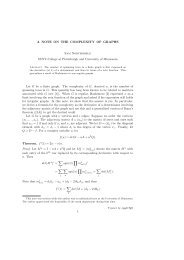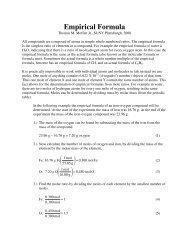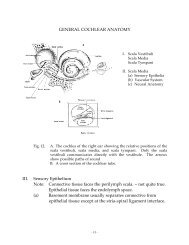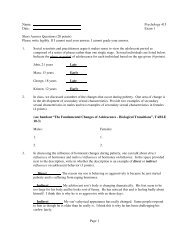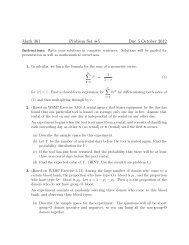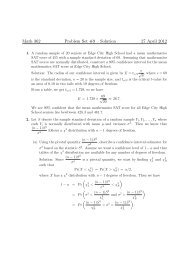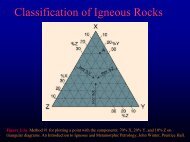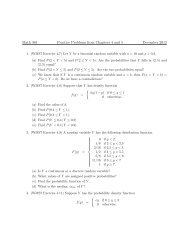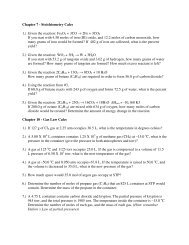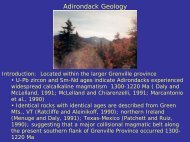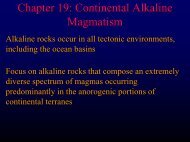Chapter 18: Granitoid Rocks - Faculty web pages
Chapter 18: Granitoid Rocks - Faculty web pages
Chapter 18: Granitoid Rocks - Faculty web pages
- No tags were found...
Create successful ePaper yourself
Turn your PDF publications into a flip-book with our unique Google optimized e-Paper software.
<strong>Chapter</strong> <strong>18</strong>: <strong>Granitoid</strong> <strong>Rocks</strong>“<strong>Granitoid</strong>s” (sensu lato): loosely applied to a widerange of felsic plutonic rocksFocus on non-continental arc intrusivesAssociated volcanics are common and have sameorigin, but are typically eroded away
<strong>Chapter</strong> <strong>18</strong>: <strong>Granitoid</strong> <strong>Rocks</strong>Generalizations:1) Most granitoids of significant volume occur in areaswhere the continental crust has been thickened byorogenyEither continental arc subduction or continentalcollisionMany granites may post-date the thickening event bytens of millions of years.
2) Because the crust is solid in its normal state, somethermal disturbance is required to form granitoids3) Thought the majority of granitoids are derived bycrustal partial meltingMantle may also be involvedMantle contribution may range from a heat sourcefor crustal partial melting to source of material aswell
<strong>Granitoid</strong> Petrography• Medium to coarse-grained, slow cooling and presence ofvolatiles, especially H 2 O• Plagioclase, qtz, , alkali feldspar – dominant felsic phases• Hornblende and biotite – dominant mafic phases• Muscovite – common in Al-rich granites• Cpx – subordinate• Accessory minerals – apatite, zircon, magnetite, ilmenite,monazite, sphene, allanite, , tourmaline, pyrite, and fluorite
Zircon Xenocrysts – Hard, refractoryand commonly survive both chemicaland mechanical weathering.Can be eroded from an igneous source,transported, deposited and buried andmetamorphosed.Pure metamorphic zircons are unzoned.Used in U-PbUdating because of highconcentration of U.If zircons remain after melting (restite(restite),they may contain inherited Pb from theirformer lives and yield an erroneous age.Figure <strong>18</strong>-1. Backscattered electron image of a zircon from the StrontianGranite, Scotland. The grain has a rounded, un-zoned core (dark) that is aninherited high-temperature non-melted crystal from the pre-granite source.The core is surrounded by a zoned epitaxial igneous overgrowth rim,crystallized from the cooling granite. From Paterson et al. (1992), Trans.Royal. Soc. Edinburgh. 83, 459-471. Also Geol. Soc. Amer. Spec. Paper, 272,459-471.
Enclaves – Igneous InclusionsTable <strong>18</strong>-1. The Various Types of EnclavesName Nature Margin Shape FeaturesXenolith piece of country sharp to angular contact metamorphicrocks gradual to ovoid texture and mineralsXenocryst isolated foreign sharp angular corrodedcrystalreaction rimSurmicaceous residue of melting sharp, lenticular metamorphic textureEnclave (restite) biotite rim micas, Al-rich mineralsSchlieren disrupted enclave gradual oblate coplanar orientationFelsic Micro- disrupted sharp to ovoid fine-graniedgranular Enclave fine-grained margin gradual igneous textureMafic Micro- Blob of coeval mostly ovoid fine-graniedgranular Enclave mafic magma sharp igneous textureCumulate Enclave disrupted mostly ovoid coarse-grained(Autolith) cumulate gradual cumulate textureAfter Didier and Barbarin (1991, p. 20).Table <strong>18</strong>-1. Didier, J. and Barbarin (1991) The different type of enclaves in granites: Nomenclature. In J. Didier and B. Barbarin(1991) (eds.), Enclaves in Granite Petrology. Elsevier. Amsterdam, pp. 19-23.
Alumina saturation: Peraluminous – Al 2 O 3 >Na 2 O+K 2 O+CaOMetaluminous - Al 2 O 3 >Na 2 O+K 2 OPeralkaline - Al 2 O 3
<strong>Granitoid</strong> classification: S-I-A-M S M (Chappell and White,1974):I-type– derived by partial melting of mafic mantle-derivedigneous source probably sub-crustalunderplate, , e.g., Andeangranites• metaluminous to peraluminous• common oxide is magnetite• hornblende-richrich
<strong>Granitoid</strong> classification: S-I-A-M S M (Chappell and White,1974):S-type– derived by partial melting of peraluminoussedimentary rks imprinted by weathering at Earth’s s surfaceCommon concentration inland from trench, e.g., SierraNevada• Always peraluminous• common oxide is ilmenite• biotite-rich and contain cordierite, may contain muscovite,andalusite, sillimanite or garnet
M-type– direct mantle source; includes both immature arcplutons and oceanic plagiogranites found in ophiolites-oceanic crust (White, 1979)A-type– anorogenic, , commonly intruded into non-orogenicorogenicsettings• generally higher in SiO 2 , alkalies, , Fe/Mg, halogens F andCl, Zr than I-typesI
Table <strong>18</strong>-3. The S-I-A-M Classification of <strong>Granitoid</strong>sType SiO 2 K 2 O/Na 2 O Ca, Sr A/(C+N+K)* Fe 3+ /Fe 2+ Cr, Ni δ <strong>18</strong> O 87 Sr/ 86 Sr Misc PetrogenesisM 46-70% low high low low low < 9‰ < 0.705 Low Rb, Th, U Subduction zoneLow LIL and HFS or ocean-intraplateMantle-derivedI 53-76% low high in low: metal- moderate low < 9‰ < 0.705 high LIL/HFS Subduction zonemafic uminous to med. Rb, Th, U Infracrustalrocks peraluminous hornblende Mafic to intermed.magnetite igneous sourceS 65-74% high low high low high > 9‰ > 0.707 variable LIL/HFS Subduction zonehigh Rb, Th, Umetaluminous biotite, cordierite SupracrustalAls, Grt, Ilmenite sedimentary sourceA high Na 2 O low var var low var var low LIL/HFS Anorogenic→ 77% high peralkaline high Fe/Mg Stable cratonhigh Ga/Al Rift zoneHigh REE, ZrHigh F, Cl* molar Al 2 O 3 /(CaO+Na 2 O+K 2 O) Data from White and Chappell (1983), Clarke (1992), Whalen (1985)
Classification based on tectonic settingOrogenic – Mt. building resulting from compressive stresses associatedwith subductionOceanic granitoids – rare, plagiogranites formed at mid-ocean ridges(ophiolites)Continental arc granites – major batholith beltsContinental collision granites – Himalayas; suture zones –faults separatingterranes of contrasting lithology, paleo-fauna,paleomagnetismTable <strong>18</strong>-4. A Classification of <strong>Granitoid</strong> <strong>Rocks</strong> Based on Tectonic Setting. After Pitcher (1983) in K. J. Hsü (ed.), MountainBuilding Processes, Academic Press, London; Pitcher (1993), The Nature and Origin of Granite, Blackie, London; and Barbarin(1990) Geol. Journal, 25, 227-238. Winter (2001) An Introduction to Igneous and Metamorphic Petrology. Prentice Hall.
Anorogenic – magmatism within a plate or at a spreading plate marginAssociated w/broad diffuse extension or intracontinental riftsGreatest anorogenic event occurred in Proterozoic when huge volumeswere emplaced along 6000 km belt extending from S California toLabrador and across Greenland to the Baltic shield (all part of one supercontinentat that time)AMCG suite – (anorthosite, mangerite, charnockite and granite) typicalProterozoic association; characteristic of parts of ADKs
Transitional - Post-orogenic (after true orogenic event); 10-100 Maafter compressive deformation stopped. Emplaced during uplift andextensional collapse following orogeny
Himalayas – Continent – continent collisionFigure <strong>18</strong>-7. Schematic cross section of the Himalayas showing the dehydration and partialmelting zones that produced the leucogranites.After France-Lanord and Le Fort (1988) Trans. Roy. Soc. Edinburgh, 79, <strong>18</strong>3-195. Winter (2001) An Introduction to Igneous andMetamorphic Petrology. Prentice Hall.



